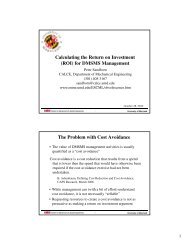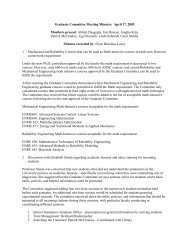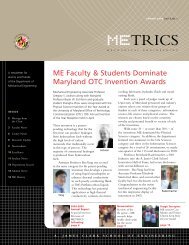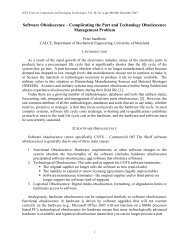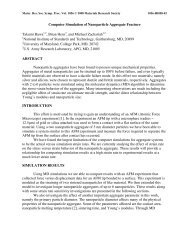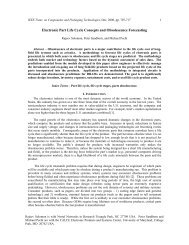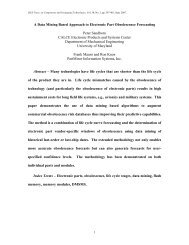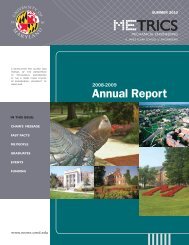METRICS - Mechanical Engineering - University of Maryland
METRICS - Mechanical Engineering - University of Maryland
METRICS - Mechanical Engineering - University of Maryland
You also want an ePaper? Increase the reach of your titles
YUMPU automatically turns print PDFs into web optimized ePapers that Google loves.
PH.D. STUDENT JIE GU EARNS IEEE<br />
RELIABILITY SCHOLARSHIP<br />
Jie Gu has been selected for the 2007 IEEE<br />
Reliability Scholarship in recognition <strong>of</strong> his<br />
activity in the IEEE reliability society. Jie Gu<br />
is advised by Pr<strong>of</strong>essor Michael Pecht <strong>of</strong> The<br />
Center for Advanced Life Cycle <strong>Engineering</strong><br />
(CALCE). The focus <strong>of</strong> his research is<br />
prognostics and health management <strong>of</strong><br />
electronics.<br />
The competition for this scholarship was<br />
strong, and the fact to be chosen to receive a<br />
scholarship is a testimony to the outstanding<br />
scholastic achievements and demonstrated<br />
interest in IEEE and reliability-related<br />
pr<strong>of</strong>essional activities.<br />
KERMANI AWARDED HULKA<br />
ALTERNATIVE ENERGY FELLOWSHIP<br />
Graduate student Elnaz Kermani was the<br />
recipient <strong>of</strong> the Barbara Hulka Fellowship<br />
this July in support <strong>of</strong> her research towards<br />
the “Cooling <strong>of</strong> Photovoltaic Arrays for<br />
High Efficiency Solar Energy Conversion<br />
�������������������������������������������<br />
eco-friendly power generation base. The<br />
fellowship was established to support the<br />
research <strong>of</strong> a graduate student working on<br />
alternative energy generation or storage<br />
such as solar energy, wind, geothermal, tidal<br />
and hydroelectric. Kermani is advised by<br />
������������������������<br />
A. JAMES CLARK SCHOOL <strong>of</strong> ENGINEERING � GLENN L. MARTIN INSTITUTE <strong>of</strong> TECHNOLOGY<br />
BIO-INSPIRED DESIGN TAKES TIME-TESTED CONCEPTS FROM NATURE. BAMBOO<br />
(LEFT) INSPIRES FUNCTIONALLY GRADED MATERIALS. THE IDEA OF VELCRO WAS<br />
BORROWED FROM THE PLANT BURR (LOWER RIGHT). (TOP RIGHT) AN ENME 489L:<br />
BIO-INSPIRED ROBOT PROJECT CAD DESIGN BASED ON A CROCODILE’S METHOD OF<br />
LOCOMOTION.<br />
designFEATURE<br />
BIO-INSPIRED DESIGN<br />
The bio-inspired curriculum on page 7 developed by Associate<br />
Pr<strong>of</strong>essor Hugh Bruck, Associate Pr<strong>of</strong>essor Satyandra K. Gupta, and<br />
Emeritus Pr<strong>of</strong>essor Edward Magrab is explained in depth on the<br />
Biologically-Inspired Product Development website at<br />
www.bioinspired.umd.edu as follows:<br />
Why should engineers look at nature’s designs when they have<br />
been developing and improving engineering methods for hundreds<br />
<strong>of</strong> years? The answer is that nature has been “engineering” its<br />
creations for millions <strong>of</strong> years. As a result, nature <strong>of</strong>fers engineers a<br />
blueprint <strong>of</strong> its designs that after several “redesigns” have become:<br />
Effective: nature has had millions <strong>of</strong> years to evolve and perfect its<br />
designs to solve specific problems and be best suited for a given<br />
environment. As a result, nature produces designs that deliver high<br />
performance and functionality. For example, biological materials,<br />
such as wood or antler bone, exhibit exceptional performance due<br />
to the detail <strong>of</strong> their design. Such effectiveness is also present in<br />
nature’s manufacturing processes, which are able to shape and<br />
assemble materials far better than our current capabilities. As a<br />
result, nature produces structures that have multi-material design,<br />
geometrically complex interfaces, continuous material grading,<br />
massively parallel assemblies, and achieve a high degree <strong>of</strong><br />
articulation.<br />
Efficient: nature’s designs are based upon the minimum use <strong>of</strong><br />
energy. Many living things, including animals and plants, have<br />
evolved such that they expend the least amount <strong>of</strong> energy and<br />
resources that are needed to survive. Additionally, nature is<br />
able to produce very diverse products from only a few common<br />
components, whereas we use a great number <strong>of</strong> materials and<br />
components to achieve new designs. Therefore, adapting ideas<br />
from nature to engineering problems may result in more efficient<br />
and less costly solutions in terms <strong>of</strong> both design and manufacturing.<br />
Adaptive: every part <strong>of</strong> nature is constantly changing, in the sense<br />
<strong>of</strong> both short-term adaptation and long-term evolution. Animals<br />
and plants are always responding to their environment and <strong>of</strong>ten<br />
adapt their shape or structure accordingly. This ability translates<br />
to designs that may be able to adapt their geometry or orientation<br />
to best suit the current conditions. Additionally, engineers may<br />
be able to create materials and structures that evolve over time,<br />
constantly modifying their design. Such an idea may even extend to<br />
creating materials and structures that are able to design themselves.<br />
13




